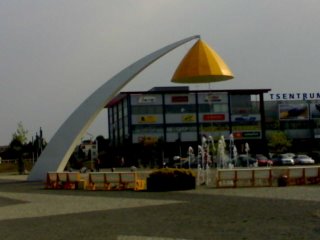


Dear Blogspot
Once again, I am thrilled to experience new kind of Estonia. Or, new to me. These places are quite old. Older than almost anything in Finland.
We drove through Estonia, Mr HP, Miss Funnybunny and I. Decided not to eat before Rakvere. And, as you can see, the centre is quite modern. (the first two photos.) Perhaps they need to built ugly and ridiculous landmarks because they have one of the oldest ruins of a beautiful stronghold in Estonia. There must be some balance in life, you see.
Then to Sillamäe. There were pipes and plumbs circling all over the place. They always, always have pipes some 2-5 meters above the ground in the Soviet Union where ever they have nuclear installations. Been there, seen that. Are they trying to capture the extra heat, or what?
The Sillamäe architecture is neat and Soviet. Yet kind of good-looking. Especially according to Mr HP!
During the past decades, things must have been ok for the Chosen Ones, who have been priviledged enough to work in the Secret City.

We came to Narva at night. No, it was 8 pm really, but for tired and bored Miss Funnybunny it was like night. We relaxed just for a while on a terrace of hotel King next to our hotel Etapp, and met friends from Hufvudstadsbladet, a Finnish daily . All these 30 funny (and tipsy) travellers represented the Swedish speaking minority in Finland, and they eventually sympathised the poor Russian minority in Estonia. To burst out this feeling of stregth they sang "March from Pori", Porilaisten marssi, in Swedish, of course.
That was when Miss F and I realised it is time to go to bed now.
(We would have sang, too, because we sympathise quite a bunch of minorities, but did not know the words. How lucky!)


3 comments:
I think your'e exaggerating a bit there. To say that all of us in our little group of Fenno-Swedes "sympathize with the poor Russian minority in Estonia" is true in a way, since minorities tend to sympathize with other minorities. But it's only half the truth -- and when we speak about extremely polarized societies as Estonia, half-truths are dangerous. It's self-evident that we also sympathize with Estonia and the Estonian-speaking Estonians (my husband didn't learn Estonian out of love for the Russian-speaking minority), and we try to understand arguments and opinions on both sides (or, to put it more exactly: all sides, since there are in fact more than two...).
And the "Porilaisten marssi" was a lame attempt to irritate the horde of Swedes (i.e. "Swedo-Swedes") who had arrived in Narva in order to re-enact the battles of 1700 and 1704 between Peter the Great of Russia and Charles XII of Sweden. But it turned out that these guys were well aware that half of the Swedish troups in fact were Finnish, so the provocation was totally unnecessary. And they loved the march...
We all loved the march! And I love especially the fact that some minority could symphatise the ill-treated Russians. No, this irony is too harsh, I know... But I'M SORRY, I CAN'T HELP IT!
IStori
>Perhaps they need to built ugly and ridiculous landmarks because....
Almost anything not clearly new is associated with poverty - like it was when I was growing up in England in the 60s and also living in the middle of a small village in middle Finland in the 80s... I can imagine it will be 20 years before people feel any different.. If you visited Tartu though - you would see some surprising new architecture which is very stylish..
>Are they trying to capture the extra heat, or what?
Well - in the short term it's obviously a lot cheaper to build pipes over ground - but I am sure that they were also more beautiful (in the style of old transparent electromechanical telephones), at least to the builders, a visible monument to free heat for the people - they are heating pipes for the blocks of flats - nothing to do with nuclear. By the way, they have just been buried, largely because of the heat waste, with the help of a massive grant from Norway!
> During the past decades, things must have been ok for the Chosen Ones, who have been priviledged enough to work in the Secret City.
Local Estonians have told me that this is entirely true. Apart from the relatively luxurious accomodation, it was possible to buy stuff here that other (ie ethnically estonian) people could not. They even had palm trees on the main boulevard - clearly for the brave few - and this was not for propaganda - it was after all a secret city.
Post a Comment